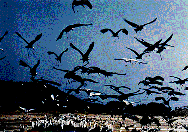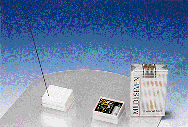

|
|
Most of the wild birds seen in Japan are migratory birds. In order to protect wild birds you must protect the environment across their entire migration path. This means it is necessary to find out as much as possible about their migratory path including breeding sites, wintering sites, and migratory resting sites.
Based on the Algos System, using artificial space satellites, NTT developed a super-compact tracking device to attach to migratory birds for tracking their migratory path and cooperated in studying collected data. In addition to studying the migratory paths of cranes and swans in cooperation with the Japan Wild Bird Association and participating in a study of migratory birds conducted by the US's Department of Fish, Game and Wildlife, we are also cooperating with Russia and the US in studying how to bring migrating Hakugan back to Japan.
In addition to these activities, we are also removing telephone poles from wetlands and switching to wireless systems to protect birds from telephone lines and using old telephone poles to build nest boxes to help protect wild birds.
|



